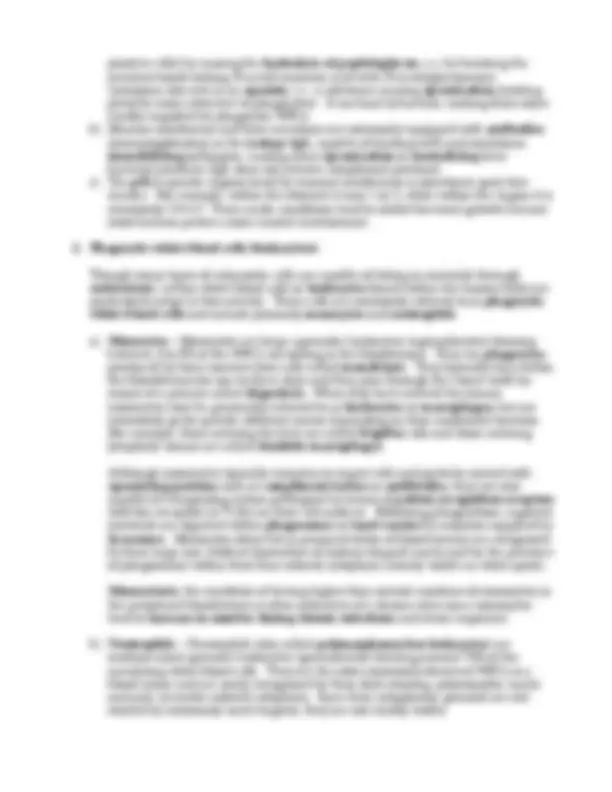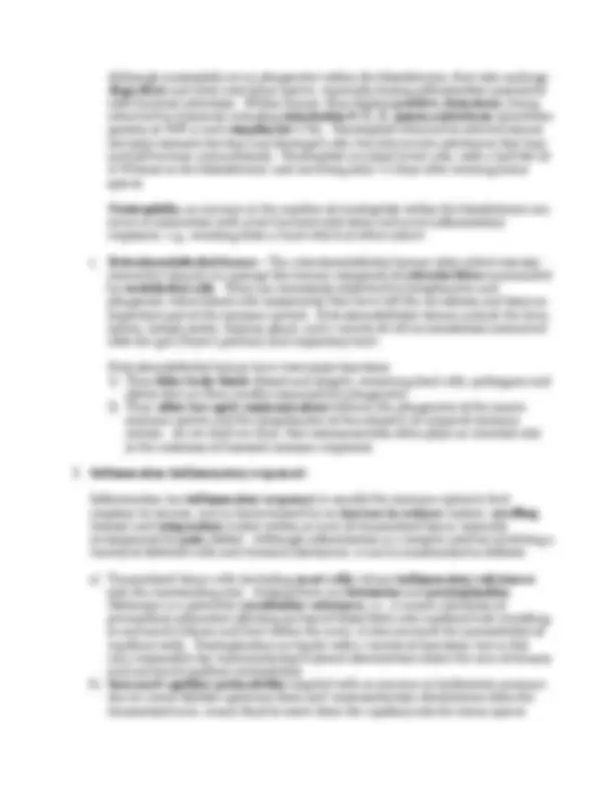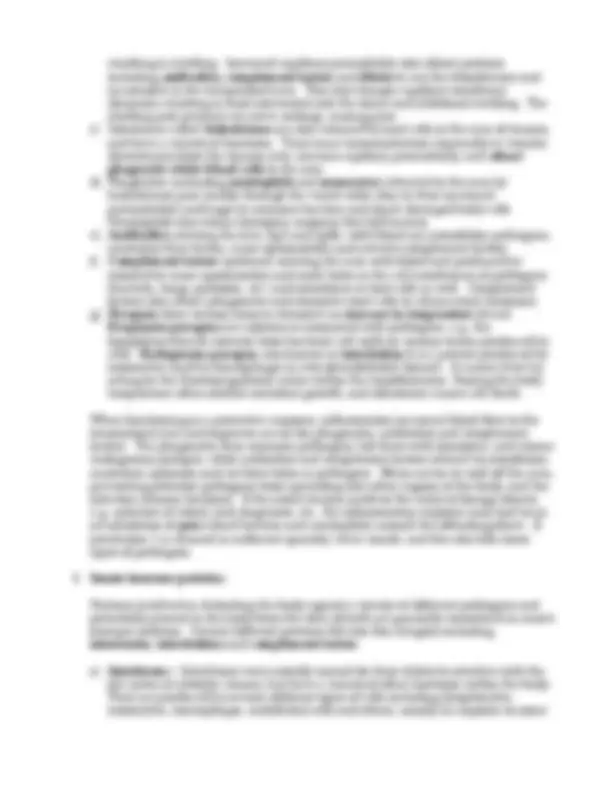





Study with the several resources on Docsity

Earn points by helping other students or get them with a premium plan


Prepare for your exams
Study with the several resources on Docsity

Earn points to download
Earn points by helping other students or get them with a premium plan
Community
Ask the community for help and clear up your study doubts
Discover the best universities in your country according to Docsity users
Free resources
Download our free guides on studying techniques, anxiety management strategies, and thesis advice from Docsity tutors
An overview of the structures and mechanisms involved in maintaining immunity, focusing on innate immunity and its role in protecting the body from pathogens. Topics include the functions of skin and mucous membranes, phagocytic white blood cells, and reticuloendothelial tissues. The text also discusses the roles of various cells, tissues, and immune substances in providing mechanical and chemical barriers against potential pathogens.
Typology: Study notes
1 / 7

This page cannot be seen from the preview
Don't miss anything!




Harriet Wilson, Lecture Notes Bio. Sci. 4 - Microbiology Sierra College
Microorganisms are abundant in the environment, and though most of them are not pathogenic, some of them are or potentially so depending on circumstances. Fortunately, the human body is well equipped to defend itself against a wide variety of potential pathogens. Despite the "hype" proliferated on television and radio, normally functioning humans, even young ones, do not require that disinfectants and antiseptics be used regularly to "protect" them from the multitude of "germs" lurking in the environment. In fact, raising children in ultra-clean environments is now recognized as having detrimental consequences, e.g., increasing the incidence of allergic reactions. Humans have been living with microorganisms for thousands of years, and we are well adapted to their presence. Immunity – Immunity can be defined as resistance to or the ability to resist infection and disease. Although immunity can be though of as being maintained by an immune system , in actuality, it is dependent on a variety of structures and mechanisms involving many different types of cells, tissues and organs. Humans vary considerably with respect to their ability to resist disease, so for this section, assume the information presented applies to a normal, healthy individual with a fully functional immune system. For convenience, immune mechanisms are often divided into two categories, innate (non-specific) and adaptive or acquired (specific immunity) as described below. Innate immunity: Innate immunity is resistance to or ability to resist infection and disease that is built in , or present at birth. All immune mechanisms involve cells and tissues that are present when an individual is born, but adaptive or acquired immunity typically involves some type of interaction with an external agent; an antigen , while innate immunity does not. Innate immunity is generally non-specific , i.e., it provides defense against multiple different types of pathogens, while adaptive or acquired immunity ends to be quite specific. The cells, tissues and immune substances involved in innate immunity are more varied and wide spread than are those associated with adaptive or acquired immune responses (at lease superficially), and often not considered part of the immune system proper (though they are here). Some important structures and defense mechanisms associated with innate immunity are described below.
and mucous membranes provide both mechanical ( physical ) and chemical barriers against potential pathogens. Mechanical aspects of dry skin include the following: a) The skin is multilayered , i.e., it includes an epidermis composed of epithelial cells supported by an underlying dermis , a layer of dense connective tissue. The epidermis is composed of stratified squamous epithelium , so is itself a multilayered structure, with flattened surface cells. b) Cells at the skin surface are highly keratinized , i.e., contain high levels of keratin proteins. These are tough, insoluble, fibrous proteins that interconnect to help make skin surfaces effective mechanical barriers. c) Cells at the skin surface are dead and constantly being shed , taking microorganisms with them. Many of the bacteria commonly found on air plates are inhabitants of human skin shed regularly by their human hosts. d) The dermis is composed of dense connective tissue, and forms a tough , leather-like barrier that is difficult to penetrate. Collagen , a long, fibrous protein with great tensile strength is one of the primary components. Note – Leather is typically made from animal hides (dermis layers) so accurately represents dermis structure. Chemical aspects of dry skin include the following: a) The skin surface is salty , due to the evaporation of water at the skin surface during thermoregulation and the natural salt content of sweat (perspiration). Salt in association with keratin makes the skin surface hypertonic , and inhospitable for many types of microorganisms. b) The skin surface is often acidic (pH around 5.5) and this also tends to inhibit microbial growth, as most bacteria prefer a pH around 7. This acidity is due primarily to the keratinization of epithelial cells as they move toward the skin surface. c) Oils and waxes produced by the sebaceous glands help waterproof the skin and prevent it from drying and cracking. Some of these also inhibit microbial growth. Mechanical aspects of mucous membranes include the following: a) Mucous membranes are multilayered , i.e., like dry skin they always include an epithelial layer supported by an underlying layer of connective tissue. The type of epithelium is variable. b) Mucous membranes are often covered with a thick, sticky material called mucus. Within the respiratory tract, mucus traps dust and microorganisms entering with inspired air and prevents them from reaching the lungs. Mucus moistens and lubricates the mouth and esophagus, allowing food materials to be readily masticated and swallowed. Within the stomach, mucus provides a protective layer preventing infection and damage to epithelial cells potentially caused by the acidic environment present. Cervical mucus also helps prevent infection. c) Within the respiratory system the epithelium is ciliated and the cilia sweep potential pathogens trapped in mucus, up and out of the airways. Since smoking causes damage to cilia, smokers are more likely to experience lung infections as bacteria are more likely to enter their lungs. Chemical aspects of mucous membranes include the following: a) Mucus and other secretions often associated with moist surfaces, e.g., tears and saliva, contain lysozyme enzymes. Lysozyme kills bacteria (especially Gram-
Although neutrophils act as phagocytes within the bloodstream, they also undergo diapedesis and enter into tissue spaces, especially during inflammation associated with bacterial infections. Within tissues, they display positive chemotaxis , being attracted by chemicals including interleukin- 8 (IL-8), gamma-interferon (interferon gamma or INF-γ) and compliment (C5a). Neutrophils attracted to infected tissues not only consume bacteria and damaged cells, but also secrete substances that trap and kill bacteria extracellularly. Neutrophils are short-lived cells, with a half-life of 4 - 10 hours in the bloodstream, and surviving only 1-2 days after entering tissue spaces. Neutrophilia , an increase in the number of neutrophils within the bloodstream can occur in association with acute bacterial infections and acute inflammatory responses, e.g., resulting from a heart attack or other infarct. c. Reticuloendothelial tissues – The reticuloendothelial tissues (also called reticular connective tissues) are sponge-like tissues composed of reticular fibers surrounded by endothelial cells. These are commonly inhabited by lymphocytes and phagocytic white blood cells (monocytes) that have left the circulation and form an important part of the immune system. Reticuloendothelial tissues include the liver, spleen, lymph nodes, thymus gland, and a variety of cell accumulations associated with the gut (Peyer's patches) and respiratory tract. Reticuloendothelial tissues have two major functions:
resulting in swelling. Increased capillary permeability also allows proteins including antibodies, complement factors and fibrin to exit the bloodstream and accumulate in the traumatized area. This also changes capillary membrane dynamics resulting in fluid movement into the tissue and additional swelling. The swelling puts pressure on nerve endings, causing pain. c) Substances called leukotrienes are also released by mast cells in the area of trauma, and have a variety of functions. They cause vasoconstriction (especially in venules downstream from the trauma site), increase capillary permeability, and attract phagocytic white blood cells to the area. d) Phagocytes (including neutrophils and monocytes ) attracted to the area by leukotrienes pass readily through the vessel walls (due to their increased permeability) and begin to consume bacteria and dead/damaged body cells. Neutrophils also release lysozyme enzymes that kill bacteria. e) Antibodies entering the area (IgG and IgM), with blood can immobilize pathogens, neutralize their toxins, cause opsonization and activate complement factors. f) Complement factors (proteins) entering the area with blood and produced by monocytes cause opsonization and make holes in the cell membranes of pathogens (bacteria, fungi, protozoa, etc.) and sometimes in host cells as well. Complement factors also attract phagocytes and stimulate mast cells to release more histamine. g) Pyrogens from various sources stimulate an increase in temperature (fever). Exogenous pyrogens are substances associated with pathogens, e.g., the lipopolysaccharide material from bacterial cell walls or various toxins produced by cells. Endogenous pyrogen , also known as interleukin 1 , is a protein produced by monocytes (and by macrophages in reticuloendothelial tissues). It causes fever by acting on the thermoregulatory center within the hypothalamus. Raising the body temperature often inhibits microbial growth, and sometimes causes cell death. When functioning as a protective response, inflammation increases blood flow to the traumatized area and improves access for phagocytes, antibodies and complement factors. The phagocytes then consume pathogens, kill them with lysozyme, and release endogenous pyrogen, while antibodies and complement factors interact to immobilize, neutralize, opsonize and/or blow holes in pathogens. Fibrin serves to wall off the area, preventing potential pathogens from spreading into other regions of the body, and the infection remains localized. If the initial trauma involves the entry of foreign objects, e.g., splinters of wood, rock fragments, etc., the inflammatory response may lead to an accumulation of puss (dead bacteria and neutrophils) around the offending object. If interleukin 1 is released in sufficient quantity, fever results, and this also kills some types of pathogens.
respiratory tracts are not pathogenic. Instead, these organisms help to defend us against other organisms that are. Organisms living as normal flora associated with skin and mucous membranes protect our cells and tissues in a variety of ways as described below.